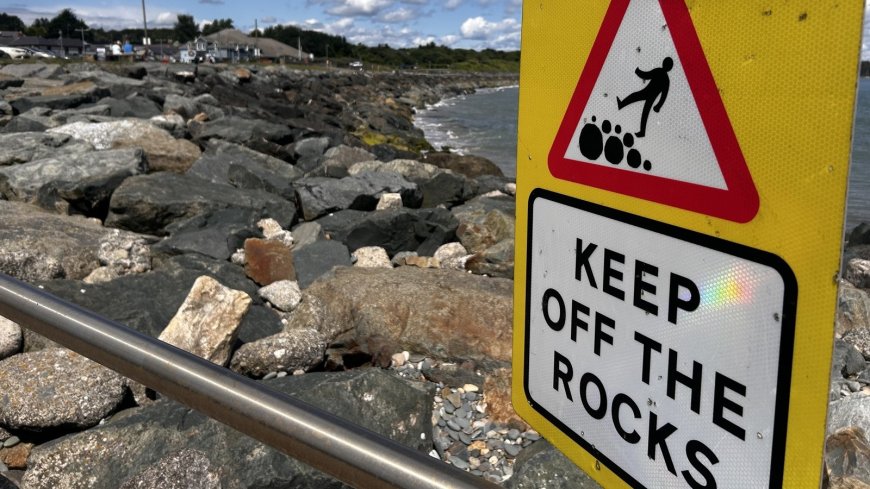Government Urged to Create Guidelines for Climate Change and Coastal Erosion
Calls have been made for the government to establish national guidelines to manage the impact of climate change on coastal areas. The erosion of Courtown beach in Co Wexford has raised concerns, with rock armour being used to combat the loss of shoreline. Experts emphasize the need for a strategic approach to coastal protection amidst ongoing challenges.

There have been renewed calls for the Government to draw up national guidelines on how to best manage the effects of climate change on our coasts. It comes as a debate continues in one of the most vulnerable beach villages as to how best protect its shoreline against erosion. For the beach alone it was the place to be - Courtown, Co Wexford. But that that golden stretch, so popular in the decades leading up to the 1980s, is now long gone, with rock armour now piled high where the sand once was. Visitors still come, but not as many. \"It's absolutely decimated the place, it was the number one draw. We had an award winning Blue Flag beach, and we don't anymore,\" said Linda Sinnott from the Courtown Community Council. \"The decline really started around the 80s in terms of coastal erosion. It kind of crept up, I don't think people realised what was happening,\" she said. \"It kicked off with storm Charlie (in 1986), and that's when these really intense winter storms started to hit. \"I think they realised that we're going to have to do something to save the beach, because we were losing it year on year.\" The rock armour was put in to try to halt the erosion, and there was a strip of beach left, but that was slowly lost too. Much of the sandy beach in Courtown has been lost to coastal erosion. It is estimated that in the last 40 years, 24 linear acres of the Courtown coastline have been eroded, equivalent to the size of around 18 soccer pitches. With the rocks now dotting a sizable stretch of the coastline, some now are wondering just how effective they have been. Coastal ecologist and director of Coastwatch Ireland Karin Dubsky lives in the area. \"We have climate change. So realistically, we will be losing a lot of our shores, and we have to make a wise choice of where we invest, because for the taxpayer, that is millions.\" She argues while rocks are needed in places where there are risks to people and property, she questions their use elsewhere, and in particular where sand dunes offer natural protection. Standing at the beach at Kiltennell, she said: \"About 25 metres of dune have eroded here since they put in the rock armour. It tells us that the rock armour didn't work, and it normally doesn't work to put rock armour on a dune. \"The impact in Courtown is that you now have millions of euros worth of rocks sitting where a dune could be and where people could be on beaches. \"I know that people might argue, 'but you would have had even more erosion'. \"Perhaps at times you would have had more erosion, but you would have a natural system trying to adjust itself.\" Karin Dubsky is calling for a wider debate on managing the challenges of climate change to Irish coastlines. In a statement, Wexford County Council said it continues to monitor the stretch of coastline at Kiltennell and said it is liaising with stakeholders. It also pointed to a wider development project in the works. Karin Dubksy is calling for a wider debate on the issue, on just how best to manage the challenges of climate change to our coastlines. \"Ireland has over 7,500 kilometres of coast,\" she said. \"We can't afford to make the whole country look like a hedgehog. Yes, you have to protect your cities and your absolute essential infrastructure. \"Is it wise to protect a dune which would adjust itself? I would maintain it isn't, but we don't have a national erosion management policy where you could feed things into.\" Coastwatch Ireland is also renewing its call for that national strategy to be drawn up. The Government has said that work on it is ongoing and it's continuing to advance it. A five-minute drive away, for the residents living near the edge, the rocks are a welcome feature. The receding coastline is a significant worry for them, so much so that they have pooled their money to lay their own rock armour. Mona Sheehan's home is perched high, overlooking the sea. \"It's a beautiful place to live, you could be in any country in Europe. It would be much nicer if we'd more protection,\" she said. \"There is that concern that over time, the sea will eventually come in further and further...it would mean that we'd have to move I suspect. \"I'm not quite sure what protection would be offered to us as regards our homes, but in time, if the sea does come in, we'd have no choice but to move.\" Despite the challenges, Linda Sinnott is optimistic about the future of the village, which she said \"has been hit very hard by coastal erosion\". She pointed to recently installed trail walks, and said there are other regeneration plans currently being formulated. \"It’s an exciting time ... we have discussed different ideas and projects, and now we're at the point where these ideas will come to fruition ... I think there's good days to come,\" she said.
What's Your Reaction?
 Like
0
Like
0
 Dislike
0
Dislike
0
 Love
0
Love
0
 Funny
0
Funny
0
 Angry
0
Angry
0
 Sad
0
Sad
0
 Wow
0
Wow
0





































































































































































